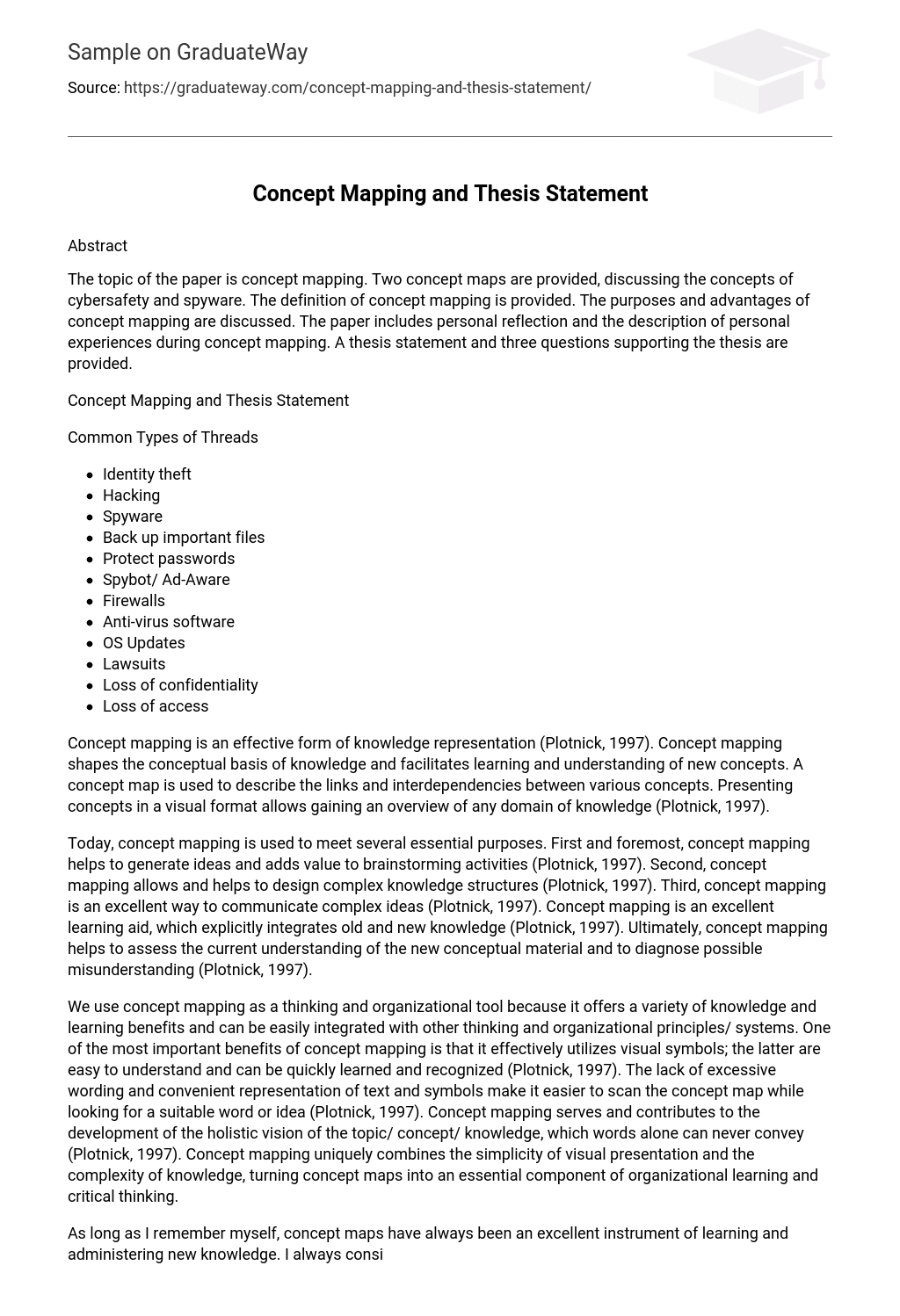Abstract
The topic of the paper is concept mapping. Two concept maps are provided, discussing the concepts of cybersafety and spyware. The definition of concept mapping is provided. The purposes and advantages of concept mapping are discussed. The paper includes personal reflection and the description of personal experiences during concept mapping. A thesis statement and three questions supporting the thesis are provided.
Concept Mapping and Thesis Statement
Common Types of Threads
- Identity theft
- Hacking
- Spyware
- Back up important files
- Protect passwords
- Spybot/ Ad-Aware
- Firewalls
- Anti-virus software
- OS Updates
- Lawsuits
- Loss of confidentiality
- Loss of access
Concept mapping is an effective form of knowledge representation (Plotnick, 1997). Concept mapping shapes the conceptual basis of knowledge and facilitates learning and understanding of new concepts. A concept map is used to describe the links and interdependencies between various concepts. Presenting concepts in a visual format allows gaining an overview of any domain of knowledge (Plotnick, 1997).
Today, concept mapping is used to meet several essential purposes. First and foremost, concept mapping helps to generate ideas and adds value to brainstorming activities (Plotnick, 1997). Second, concept mapping allows and helps to design complex knowledge structures (Plotnick, 1997). Third, concept mapping is an excellent way to communicate complex ideas (Plotnick, 1997). Concept mapping is an excellent learning aid, which explicitly integrates old and new knowledge (Plotnick, 1997). Ultimately, concept mapping helps to assess the current understanding of the new conceptual material and to diagnose possible misunderstanding (Plotnick, 1997).
We use concept mapping as a thinking and organizational tool because it offers a variety of knowledge and learning benefits and can be easily integrated with other thinking and organizational principles/ systems. One of the most important benefits of concept mapping is that it effectively utilizes visual symbols; the latter are easy to understand and can be quickly learned and recognized (Plotnick, 1997). The lack of excessive wording and convenient representation of text and symbols make it easier to scan the concept map while looking for a suitable word or idea (Plotnick, 1997). Concept mapping serves and contributes to the development of the holistic vision of the topic/ concept/ knowledge, which words alone can never convey (Plotnick, 1997). Concept mapping uniquely combines the simplicity of visual presentation and the complexity of knowledge, turning concept maps into an essential component of organizational learning and critical thinking.
As long as I remember myself, concept maps have always been an excellent instrument of learning and administering new knowledge. I always considered concept maps to be an effective element of transforming the power of word into a convenient graphic presentation format. During the concept mapping activity, I have learned how to present complex meanings, concepts, and ideas in an easy-to-understand format. More importantly, I was able to develop a holistic understanding of the problem. Finally, concept maps gave me a unique opportunity to present and explain complex relationships between numerous concepts. As a result, concept maps have proved to be an effective tool for organizing and integrating new and old knowledge into a single concept system. For me, concept mapping is always associated with learning new things, because creating a good concept map is impossible without understanding the meaning and significance of various concepts. Obviously, what I have learned will support my learning and knowledge endeavors in the future.
Thesis:
Spyware is a form of malicious software, the negative effects of which are easy to detect and prevent, if computer users are aware of the spyware risks and use technical tools and instruments, to reduce the spyware threat.
Question 1: What is spyware?
Question 2: How does spyware operate?
Question 3: How to prevent the risks and negative effects of spyware?
References
- Knapton, K. (2009). Cyber safety: Maintaining morality in a digital world. Cedar Fort.
- Plotnick, E. (1997). Concept mapping: A graphical system for understanding the relationship
- between concepts. ERIC Digest. Retrieved August 26, 2010 from http://www.ericdigests.org/1998-1/concept.htm
- US-CERT. (2008). Spyware. US-CERT. Retrieved August 26, 2010 from
- http://www.uscert.gov/reading_room/spywarehome_0905.pdf





